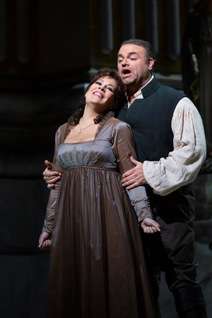|
Back
Tosca is Back! New York
Metropolitan Opera
10/25/2018 - & October 29, November 2, 5, 9*, 13, 17, 2018, March 23, 26, 29, April 2, 6, 2019
Giacomo Puccini: Tosca
Sondra Radvanovsky*/Jennifer Rowley (Tosca), Joseph Calleja (Cavaradossi), Claudio Sgura*/Wolfgang Koch/Zeljko Lucic (Scarpia), Oren Gradus (Angelotti), Patrick Carfizzi*/Philip Cokorinos (Sacristan), Brenton Ryan (Spoletta), Christopher Job (Sciarrone), Davida Dayle (Shepherd), Paul Corona (Jailer)
Metropolitan Opera Orchestra and Chorus, Carlo Rizzi (conductor)
Sir David McVicar (production), Jonathon Loy (revival director), John Macfarlane (sets and costumes), David Finn (lights), Leah Hausman (movement)

S. Radvanovsky, J. Calleja (© Marty Sohl)
As it does in most seasons, Puccini’s Tosca has returned to the Met for a hefty performance run. Sir David McVicar’s production has given the work a new lease on life in this house, premiering last New Years’ Eve after an eight-year interregnum dominated by a cheap, bland, and universally despised flop designed by the late Swiss director Luc Bondy. McVicar’s major virtue was that his approach gestured toward recreating the long beloved Franco Zeffirelli production, which had been discarded in what the Met’s general manager Peter Gelb publicly called a mistake. The visuals are a bit different, with the stunningly realistic recreations of the Church of Sant’Andrea della Valle, the Palazzo Farnese, and the Castel Sant’Angelo turned roughly on a 45-degree angle, but the public and critics alike were pleased. The new production’s start was nevertheless inauspicious – the announced conductor and all three principal leads dropped out before the curtain went up, and the initial replacement conductor turned out to be the Met’s disgraced former music director James Levine, who was removed after he was suspended due to sexual harassment allegations (Levine was unceremoniously fired following an investigation and is currently suing the Met on numerous grounds).
This season the drama was safely confined to the stage, with a respectable cast going forward relatively intact. Once infamously derided as a “shabby little shocker,” Tosca is the tale of a predictably tragic love affair. Set in Rome at a time when Italy was in contention between revolutionary France, then technically still a republic but already ruled by Napoleon, and conservative Europe, the singer Floria Tosca falls under the gaze of Rome’s lustful and corrupt police chief Baron Scarpia. Taking advantage of her love for the politically radical painter Cavaradossi and his help for an escaped political prisoner, Scarpia detains both of them and offers Cavaradossi’s freedom for Tosca’s favors. She pretends to give in, but savagely stabs her tormentor to death just after he appears to arrange to keep his word by way of a mock execution. Sadly, Scarpia had already planned a double cross, and Cavaradossi’s firing squad turns out to be a real one after all. Devastated by loss and trapped by her own murder of Scarpia, Tosca jumps to her death to tortured strains of the romantic music recalling the unhappy couple’s most tender moments.
All the opera’s principle roles demand tenacity, and it was on full display from this cast. Sondra Radvanovsky has experimented with bel canto singing in recent seasons, but her intensity and strong chest voice were deployed to better effect here. The voice has a metallic quality that not everyone likes, but she portrayed a vivid, passionate woman, plumbing the depths of Tosca’s jealousy as well as her earnestness. The part’s signature second act aria “Vissi d’arte” shimmered with modulations that drew well deserved attention and sympathy.
Joseph Calleja turned in a solid performance as Cavaradossi, but relied too heavily on his customary vibrato to pull off the high notes. The character’s resounding cry of “Vittoria,” uttered when Scarpia gets bad news from the military front, sounded more like a curiosity than an achievement. Calleja performed much better, however, in the third Act aria “E lucevan le stelle,” a quieter but powerful end-of-life reminiscence of a true love about to die in unfortunate circumstances. The young baritone Claudio Sgura made his Met debut as Scarpia this season, replacing the more familiar Zeljko Lucic, who withdrew from the revival after the first performance. With imposing height and a good sense of the role’s courtly qualities, Sgura left a strong impression and backed it up with solid vocal technique. He did not always shine through in the ensembles, and sometimes his acting, possibly through fault of the direction, compromised the emotional coolness that makes a truly memorable Scarpia. But this is certainly a voice to hear and follow. The supporting cast seemed to go through the motions more than usual. Patrick Carfizzi’s Sacristan was a campy distraction the performance could have done without.
Carlo Rizzi led a noble performance from the Met’s orchestra and chorus. His tempos were balanced, and one appreciated the effort alongside his contemporaneous work with the revival of Arrigo Boito’s Mefistofele, which opened the evening before the performance under review.
Paul du Quenoy
|